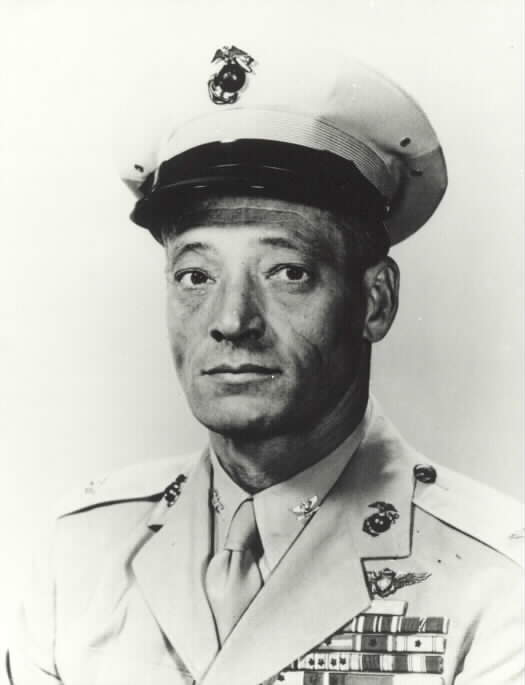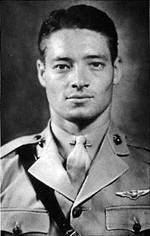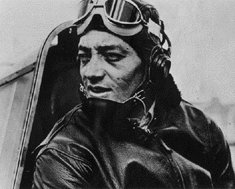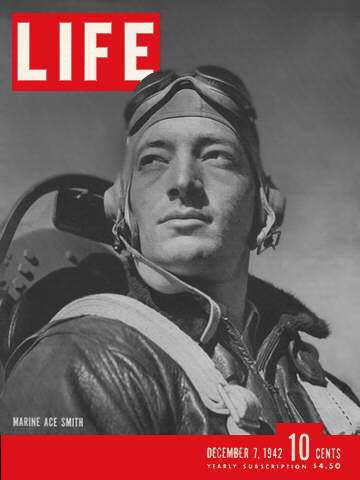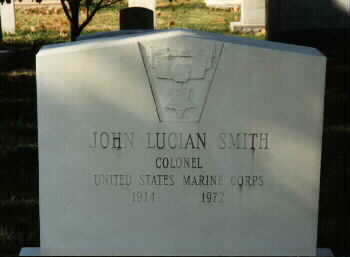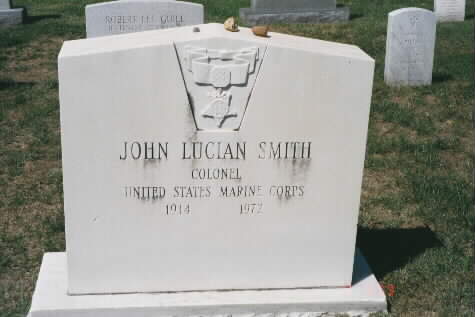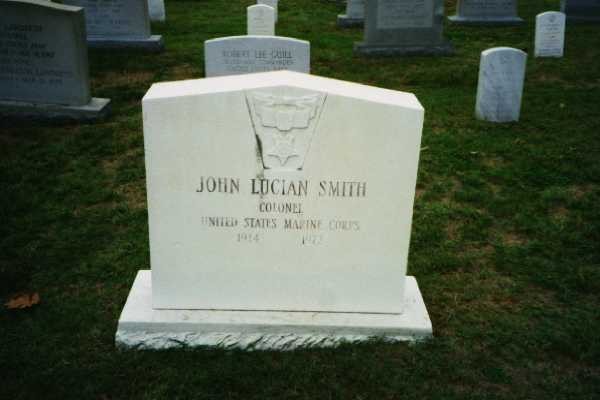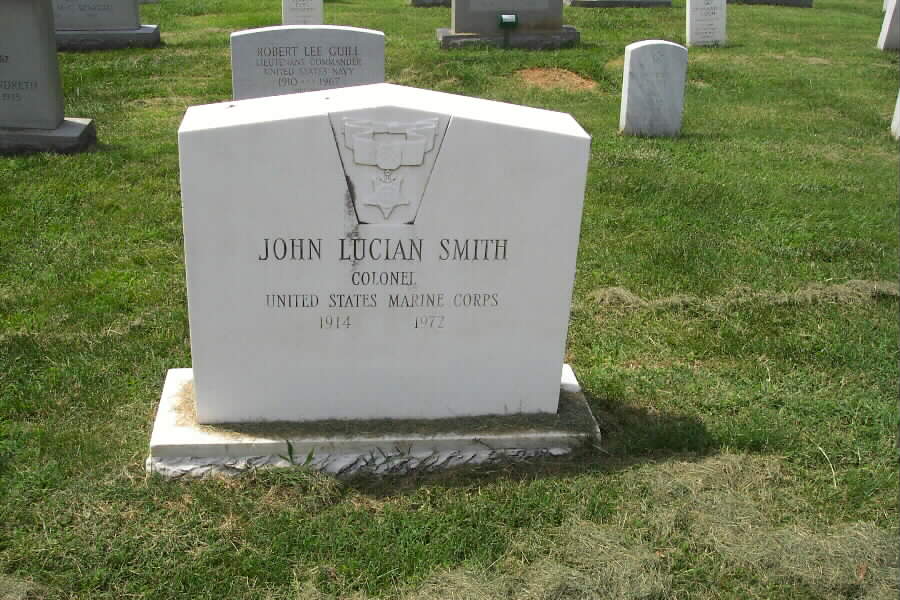Born on December 26, 1914 in Lexington, Oklahoma, he was a United States Marine Corps Air Ace who shot down 19 Japanese planes during the crucial battle for the Solomons. He led Marine Corps Fighter Group 223 on sorties against the enemy, during which the squadron accounted for 83 enemy aircraft destroyed. He received the Medal of Honor for his aerial exploits.
He retired from the Marine Corps on September 1, 1960, after which he worked in the defense industry.
Sadly, despondent over being laid-off from his position during a slowdown, he took his own life on June 9, 1972 and was buried in Section 3 of Arlington National Cemetery.
Colonel John Lucian Smith, Medal of Honor recipient and Marine Corps ace who shot down 19 Japanese planes in World War II, died June 10, 1972 at Encino, California.
During the crucial battle for the Solomons, the colonel led Marine Fighter Squadron 223 on sorties against the enemy, during which the squadron accounted for 83 enemy aircraft destroyed.
The distinguished aviator was born December 26, 1914, at Lexington, Oklahoma. He attended the University of Oklahoma where he was a member of the Reserve Officers Training Corps, graduating in May 1936. During the same month, he was appointed a second lieutenant in the Army Field Artillery, but resigned in July that year to accept a commission in the U.S. Marine Corps as a second lieutenant.
After receiving his Marine Corps commission, Colonel Smith was ordered to Marine Barracks, Navy Yard, Philadelphia, Pennsylvania, where he attended the Marine Basic School.
Following various duty assignments at Quantico, Virginia, Washington, D.C., and Parris Island, South Carolina, in 1937, he was transferred to the Naval Air Station, Pensacola, in July 1938, to begin flight training. A year later he was graduated and designated a Naval Aviator.
While on temporary duty in Washington after his return from the Pacific, Colonel Smith was awarded and presented the Medal of Honor by the late President Franklin Roosevelt, February 24, 1943.
After several months’ duty in Washington, the colonel shipped overseas again that fall to serve as Executive Officer of Marine Aircraft Group 32, then located at Oahu, Hawaii. A few months later, he moved to the Philippines and then took part in the aerial offensives in the Bismarck Archipelago in November and December 1944; moved up to Luzon in the Philippines in January and February 1945; then on to Mindoro and Mindanao, and finally up to the Sulu Archipelago.
For his services in the Philippines during the period November 1944 to June 1945, he was awarded the Legion of Merit for exceedingly meritorious conduct in the performance of outstanding service as Executive Officer for Marine Aircraft Group 32 in extensive support of ground and surface forces in the liberation of Luzon, Zamboanga Peninsula, the Sulu Archipelago, and Mindanao.
After his return to the United States in June 1945, the colonel served at the Naval Air Station, Jacksonville, Florida, until December 1945, and then was transferred to Quantico, Virginia, to serve as station operations officer. After his duty there and after performing various duties at Cherry Point, North Carolina, Washington, and Havana, Cuba, in 1946 and 1947, Colonel Smith was detached from duty at the Naval Air Station, Norfolk, Virginia, to perform duty involving flying on the staff of Commander, Air Force, Atlantic Fleet. In November 1948 he was on temporary aviation duty in England, France and Germany.
Colonel Smith was detailed as Marine Corps Aide to the Chief of Naval Operations, Navy Department, Washington, in December 1949; and in May 1951, he joined the Staff, Standing Group, of the North Atlantic Treaty Organization, for two years. Following duty with Marine Training Group 10, at the Marine Corps Air Station, El Toro, California, he began a year’s duty in Korea, in July 1953. He served first as Commanding Officer, Marine Aircraft Group 33, until February 1954, then as Assistant Chief of Staff, G-4 of 1st Marine Aircraft Wing.
Upon his return from Korea, the colonel was assigned to Headquarters Marine Corps in August 1954, and entered the National War College, completing the course in June 1955. The following month he was assigned to Marine Corps Schools, Quantico, as a Member of the Advanced Research Group, serving in this capacity until July 1956. That August he assumed his duties at Pensacola Naval Air Station as Liaison Officer on the Staff of the Chief of Naval Air Training. His rank as colonel dated from January 1, 1951.
A complete list of Colonel Smith’s medals and decorations includes: the Medal of Honor; the Legion of Merit with Combat “V”; the Distinguished Flying Cross; the Bronze Star Medal with Combat “V”, the Air Medal with three Gold Stars, indicative of four awards; the Presidential Unit Citation; the Navy Unit Commendation Ribbon with one bronze star; the American Defense Service Medal with Base clasp; the Asiatic-Pacific Campaign Medal with one silver star, indicative of 5 bronze stars; the American Campaign Medal; the World War II Victory Medal; the Navy Occupation Service Medal with European clasp; the National Defense Service Medal; the Korean Service Medal with one bronze star; the United Nations Service Medal; the Philippine Liberation Ribbon with one bronze star; the Philippine Presidential Unit Citation; and the Korean Presidential Unit Citation.
The colonel was also awarded Britain’s Distinguished Service Order “for conspicuous gallantry and distinguished service…” in the Solomons.
SMITH, JOHN LUCIAN
Rank and organization: Major, U.S. Marine Corps, Marine Fighter Squadron 223, Place and date: In the Solomon Islands area, August-September 1942. Entered service at: Oklahoma. Born: 26 December 1914, Lexington, Oklahoma. Other Navy award: Legion of Merit.
Citation:
For conspicuous gallantry and heroic achievement in aerial combat above and beyond the call of duty as commanding officer of Marine Fighting Squadron 223 during operations against enemy Japanese forces in the Solomon Islands area, August-September 1942. Repeatedly risking his life in aggressive and daring attacks, Maj. Smith led his squadron against a determined force, greatly superior in numbers, personally shooting down 16 Japanese planes between 21 August and
15 September 1942. In spite of the limited combat experience of many of the pilots of this squadron, they achieved the notable record of a total of 83 enemy aircraft destroyed in this period, mainly attributable to the thorough training under Maj. Smith and to his intrepid and inspiring leadership. His bold tactics and indomitable fighting spirit, and the valiant and zealous fortitude of the men of his command not only rendered the enemy’s attacks ineffective and costly to Japan, but contributed to the security of our advance base. His loyal and courageous devotion to duty sustains and enhances the finest traditions of the U.S. Naval Service.
Michael Robert Patterson was born in Arlington and is the son of a former officer of the US Army. So it was no wonder that sooner or later his interests drew him to American history and especially to American military history. Many of his articles can be found on renowned portals like the New York Times, Washingtonpost or Wikipedia.
Reviewed by: Michael Howard

